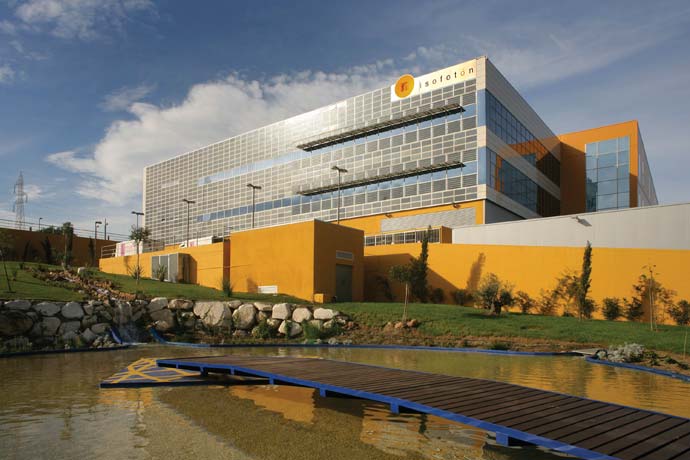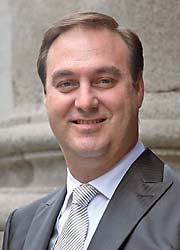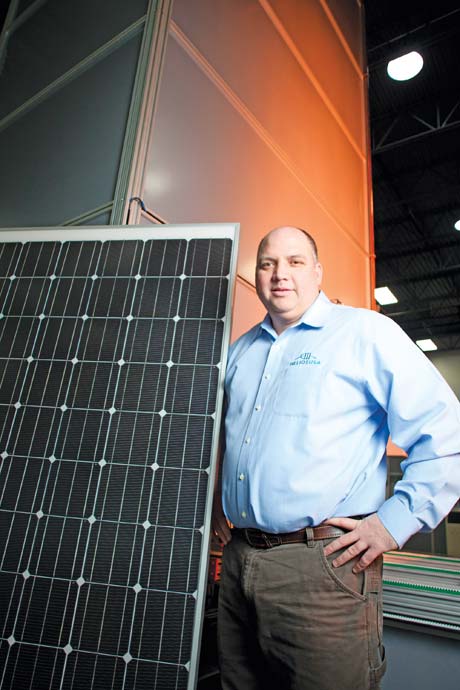Steve Ostrenga believes it’s time for some fairness in solar manufacturing. Ostrenga is CEO of Milwaukee-based Helios Solar Works, a manufacturer of mono-crystalline solar modules for solar electric systems. Helios is also a founding member of the Coalition for American Solar Manufacturing, a consortium of U.S. crystalline silicon solar technology producers that have successfully lobbied the U.S. Department of Commerce to impose preliminary tariffs on solar panels imported from China.
Ostrenga says the tariffs, which range from 2.9 to 4.73 percent depending on the manufacturer, are a good first step in achieving some fairness. Additional tariffs could be imposed in late May or early June after the Commerce Department rules on whether Chinese manufacturers have illegally dumped solar products on the U.S. market at artificially low prices.
“It’s a preliminary tariff and we know it will change,” Ostrenga says. “To me, it’s got to be the right number, a fair number. There is a guy working on the manufacturing line in China who is trying to support his family as well. It has to be the correct number for him too. There just has to be a level playing field.”
Ostrenga believes the leveling is critical to the future of U.S. solar product manufacturing. He says his company is a prime example. Helios, a two-year-old firm operating in a 40,000-sq.-ft. (3,716-sq.-m.) building, was ramping up to its goal of 50 employees last summer when it felt the sting of the cheaper Chinese imports. The company currently employs about 30, but Ostrenga is optimistic about its future growth, especially if the tariffs increase. Helios sells about 80 percent of its products in the U.S. market to residential, commercial and governmental customers.
“It is very critical when your competitor can go out there and price illegally and distort the market,” Ostrenga says. “It has repercussions. We are still out there working as hard as we can in this difficult environment and we will keep on fighting.”
Helios is one of three companies in the seven-member coalition to go public. The others are MX Solar of New Jersey and the heavyweight of the group, Oregon-based SolarWorld America, the U.S. division of Germany-based SolarWorld.
But not everyone in the industry believes tariffs are the way to go. The Coalition for Affordable Solar Energy is a group formed to oppose the action against Chinese solar products. CASE, comprising manufacturers, solar developers, system openers, retailers and installers, is a broader and larger group than CASM. The two groups have exchanged verbal salvos over the issue in recent months.
Jigar Shah is president of CASE and founder and former CEO of SunEdison, a global developer of solar power. Responding to the Commerce Department decision, Shaw said tariffs large or small hurt U.S. jobs and prolong the world’s reliance on fossil fuels.
“Fortunately, this decision will not significantly raise solar prices in the United States as SolarWorld has sought,” Shah said in a written statement. “This decision clearly demonstrates that the Commerce Department did not find the Chinese government engaged in massive subsidization, as SolarWorld and CASM claim. There is more work to be done to protect the future of solar industry and power in America. There will be another decision in May when the Commerce Department announces anti-dumping duties. A recent study by the Brattle Group confirmed that placing artificially high tariffs on solar panels would severely undermine the U.S. solar industry, resulting in the loss of up to 60,000 US jobs by 2014.”
Ostrenga says the two groups have the same goal, but differing approaches.
“Helios wants prices to decline in solar,” Ostrenga says. “As solar energy becomes more affordable, the market increases. We are 100 percent in agreement on this, but it has to be in a sustainable manner and it has got to be done legally. Period. That’s the bottom line.”
Napoleon’s Solar Campaign
Isofoton, based in Malaga, Spain, was formed in 1981 as a spin-off project at the Polytechnic University of Madrid. The global firm, which operates a factory in the Andalusia Technology Park in Malaga, formed Isofoton North America about 10 years ago with the idea of entering the U.S. market. Michael Peck, chairman of Isofoton North America, says the company’s management has long seen the U.S. market as a major opportunity, and spent three years validating the potential supply chain in Ohio before making the decision last year to locate in Napoleon, a town of about 10,000 located 40 miles (64 km.) southwest of Toledo.

The factory initially will consist of a 50-MW crystalline silicon PV module assembly line. Isofoton expects a short-term ramp-up to a 100-MW assembly line, with plans then to add a 100-MW cell line. American Municipal Power, Inc. (AMP) has agreed to purchase up to 200 MW of solar panels over five years from Isofoton’s Napoleon factory, which also has been selected by the Turning Point Solar project in Noble County, Ohio, and American Electric Power (AEP) to supply photovoltaic panels for 49.9 MW of solar energy to be erected on reclaimed mine lands.
Isofoton has been refitting a building formerly occupied by an automotive supplier. Equipment is being installed and hiring is under way. Peck says the goal is to have at least 120 people working in the factory by the end of the year. Napoleon and Ohio offered the right mix for the company, he says.
“Toledo is one of the most important solar manufacturing clusters in the country,” Peck says. “It’s where thin film was invented and has an important group of companies and investments. None do exactly what Isofoton does, so it fits in without competing against any one.”
Northwest Ohio fit nicely into the Isofoton “Strategy Triangle” of global technology, local labor and local industrial partners, Peck says. Location of production facilities near key clients helps with the company’s commitment to “place-based” sustainable labor practices. Ohio’s “solar carve-out,” which requires that a portion of the state’s renewable energy goal of 25 percent by 2025 come from solar, is another major factor.
“We ended up in the Greater Toledo metro area, just 22 minutes to the port in a rural community, which is good because it lowers our costs while being in the umbrella of the cluster,” Peck says. “We are in the territory of AMP, a leading utility. That’s important because through our many years of relationships, we have signed a letter of commitment for AMP to undertake 200 MW of off-take from our factory. When we were able to sign our letter with AMP, we wanted to locate our factory in AMP’s territory, and that led us to Napoleon.”
Peck applauds the City of Napoleon for its assistance with the project.
“Anytime you can enhance yourself with manufacturing jobs, that is a good thing,” says Jon Bisher, Napoleon’s city manager. “We had several things come together for us, all at the same time, and they are things we have worked on for a long time.”
Those things included a 100,000-sq.-ft. (9,290-sq.-m.) building built in the city’s industrial park about 18 years ago by the Community Improvement Corp. of Henry County. Bisher says the building, empty for about six months before Isofoton leased it, has served the city well through the years as home for several companies, including an automotive supplier. Another bit of good timing is the soon-to-be-completed U.S. Hwy 24 upgrade from Fort Wayne, Ind., to Toledo, known as the “Fort to Port” project. The new highway gives Napoleon Interstate-like access to Toledo.
“I didn’t use any incentives, but I had the things the company needed,” Bisher says. “Once I could provide the building, the distance, the proximity to the cluster, we had a deal. Our only claim to fame is that we are close to the solar cluster in Toledo. Sometimes it’s best to be set back a little from the cluster.”
State incentives did play a major role. The Ohio Department of Development is offering Isofoton $15.8 million in assistance in various forms including a 55-percent state income tax credit for a seven-year period for net new payroll and a total of $10.1 million in state financing. Isofoton is investing $16.4 million in the project.
Bisher made the initial connection with Peck through a connection with a software company that was locating in Napoleon.
“I found out he was involved with the Turning Point Project in southern Ohio. I called and arranged a meeting and said, ‘Look, the solar cluster is really in Northwest Ohio and you should really consider the Toledo area. There is a lot of support there for what you are doing. The University of Toledo, the Port, all of those folks know the solar business.'”
Peck describes Isofoton’s CEO, Angel Luis Serrano, as a visionary.

“He is developing a model where he invests in cutting-edge technology and innovation. He focuses on local labor buildout and major strategic industrial partnerships with leading Asian players such as CNOOC [China National Offshore Oil Corporation] and Samsung. These entities have announced major investments in Isofoton and major interest in U.S. projects. Asian blue-chip investment and U.S. labor and technology is the kind of approach that makes a lot of sense.”
Serrano, in a statement provided to Site Selection, says the company’s growth strategy is based on global and local partnerships.
“Isofton began its strategic expansion into the growing North American marketplace several years ago,” Serrano says. “By 2014 EPIA [European Photovoltaic Industry Association] predicts the U.S. market will lead global demand for photovoltaic installations, with a market share of 22 percent compared to 5 percent today. Isofoton’s strategy in the U.S. aims to respond to a market that has made a firm commitment to solar energy driven by growing demand for alternative energy solutions. The new production plant in Ohio represents the next step in the company’s international development plan in order to face the competitive market for photovoltaics.”
Peck, who was named Isofoton’s chief executive in the U.S. last year, also heads the MAPA Group, a Washington, D.C.-based consultancy specializing in helping companies in the Iberian Peninsula find business opportunities in the U.S. MAPA specializes in renewable energy companies. In addition to working with Isofoton, it assisted wind turbine company Gamesa’s location in Pennsylvania several years ago.
The opportunity to work with the University of Toledo’s Wright Center for Photovoltaics Innovation and Commercialization is a major part of Isofoton’s plans. The two entities have agreed to pursue R&D collaboration on a number of projects. Peck also credits the Toledo-Lucas County Port Authority, which has a major economic development program, as an attraction to the area.
“We were very interested in helping Isofoton find their roots in Northwest Ohio,” says Paul Toth, president and CEO of the Toledo-Lucas County Port Authority. Toth says the Port Authority help arrange meetings for Isofoton and potential suppliers in the region. The Port Authority plans to utilize Isofoton products in its proposed utility-scale solar installation projects, and its BetterBuildings Northwest Ohio program.
Rick Stansley, co-director of the Wright Center for Photovoltaics Innovation and Commercialization, says Isofoton, due to its collaboration with several universities in Spain, has an affinity to the university environment.
“The University of Toledo is a bit more entrepreneurial than most universities in the country,” Stansley says. “Our real focus is looking at the long term with companies like Isofoton that have a real need and desire to work on R&D. Their technology is mono-crystalline, but they are looking for ways to innovate. Isofoton brings a unique product to our supply chain.”
